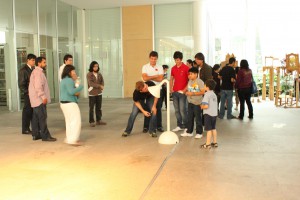Tele Echo Tube (TET) is a speaking tube installation that acoustically interacts with a deep mountain echo through the lampshade-like interface. TET consists of remote and local speaking tube systems with one-way echo canceller through a full duplex audio pipe over the globe. The remote and local systems with an identical appearance, perform a remote interaction to create an ECHO sounding and experience with Japanese ECHO (Mountain Nymph in Greek mythology), located 1,200 m above sea level. The remote tube, consisting of weather-resistant microphones and speakers, is placed in an uninhabited mountain forest at Cyberforest project site in The University of Tokyo Forests (35°94’N,138°80’E). The remote tube continuously captures and transfers the live sound to the local tube in real time through a communication satellite (LS-1300 SX) at 36,000 km altitude. The songs of small birds, the trickling of a stream, and the sounds of insects moving about in the forest represent the diversity of organisms on the forest. To interact with the ECHO, users can sing out “YO-HOOOOO!” very lively from the local tube to the speakers in the remote forest. A loopback call at the remote tube occurs while the playback sound from the speaker is captured by the mics and transferred to the local tube with spontaneous network delays (approx. 20-90 secs). When the users hear the loopback call, “their voices within the soundscape from the forest”, they cognize that the aural expression actually traveled through the forest. This loop, which pipes live sounds from the remote and local sites, creates an ECHO sounding effect. In doing so, TET gives the users an opportunity to feel the presence of “a fickle ECHO in the forest” in the midst of a city, beyond cultural and imaginable boundaries.
Awards:
-
Winner, Interface and Interaction Design Category, A’ Design Award, Italia, 2018.
-
Encouragement Prize, Telecommunications Advancement Foundation-TELECOM System Technology Award, Tokyo, Japan, 2015.
Papers:
-
Sang-won Leigh, Asta Roseway, Ann Paradiso, Hiroki Kobayashi, Michitaka Hirose, Akio Fujiwara, Kazuhiko Nakamura, Kaoru Sezaki, Kaoru Saito, Conor Peterson, Bert Bongers, and Cecilia Heffer. 2015. Demo hour. interactions 22, 4,8-11,2015.
-
Hill Hiroki Kobayashi, 2013. TELE ECHO TUBE, LEONARDO / Journal of the International Society for the Arts, Sciences and Technology (MIT Press), Vol. 46, No. 5, Pages 484-485.
-
Hiroki Kobayashi, Michitaka Hirose, Akio Fujiwara, Kazuhiko Nakamura, Kaoru Sezaki and Kaoru Saito. TeleEcho Tube: Beyond Cultural and Imaginable Boundaries. In Proceedings of the 21th international conference, ACM International Conference on Multimedia (ACM MM ’13), Barcelona, Spain, Oct 21-Oct 25, 173-182, 2013.
Presentations:
-
Hiroki Kobayashi, Kaoru Sezaki, Kazuhiko Nakamura, Akio Fujiwara and Kaoru Saito. Tele echo tube: beyond cultural and imaginable boundaries. poster. Digital Conservation Conference 2014, University of Aberdeen, Aberdeen, England. May 21-23, 2014.
Exhibitions (selected):
-
Virtual and Digital Art Section, 10th Arte Laguna Prize Exhibition, 2016, Venice, Italy.
-
ACM Tangible and embedded interaction 2015 art gallery (ACM TEI ’15), Stanford, USA. (Assistant: Ayumi Ohnishi)
-
Animals in the Dark Night Exhibition, Gunma Museum of Natural History, 2014, Gunma, Japan.
-
ACM Multimedia 2013 art gallery (ACM MM ’13), Barcelona, Spain. (Assistant: Junya Okuno)
-
(E)scapes: exploring the sonic relationship between body and space, 2013, NAISA Space, Toronto, Canada. (Support: Japan Foundation and Canada Council for the Arts. Assistant: Junya Okuno)
-
BASAL Exhibition, 2010, Museo Universitario de Arte Contemporáneo (MUAC), Mexico city, Mexico. (Assistant: Andrea Ferreiro, Interview on Youtube by Andrea Ferreiro)
-
Artech Exhibition of International Conference on ASIAGRAPH, 2008, National Museum of Emerging Science and Innovation, Tokyo, Japan.
Research Fundings:
-
JSPS Grant-in-Aid for Young Scientists (A), Believable Human-Computer-Animal Interaction for HCI Design (No:26700015), PI, 2014-2016.

